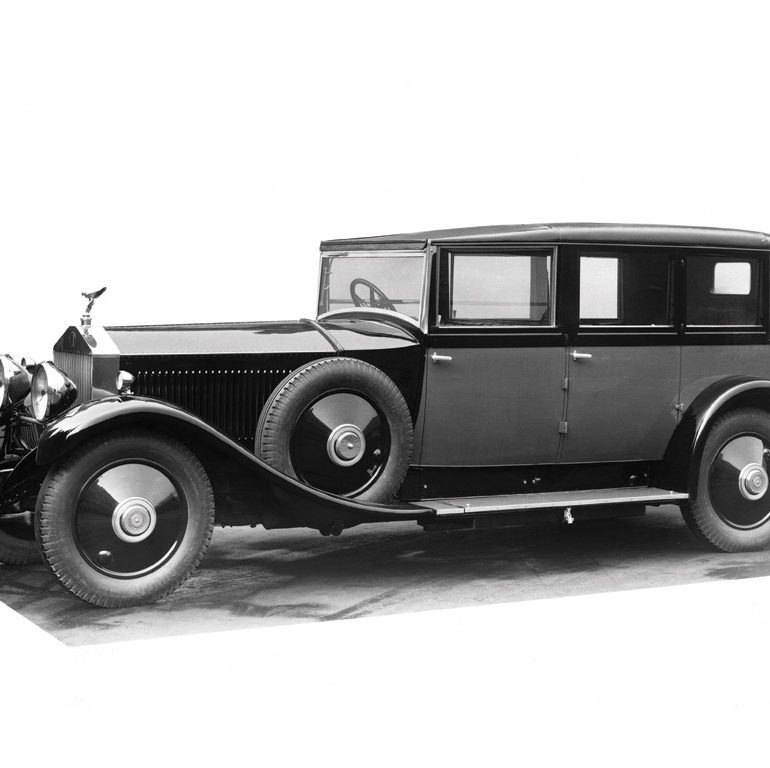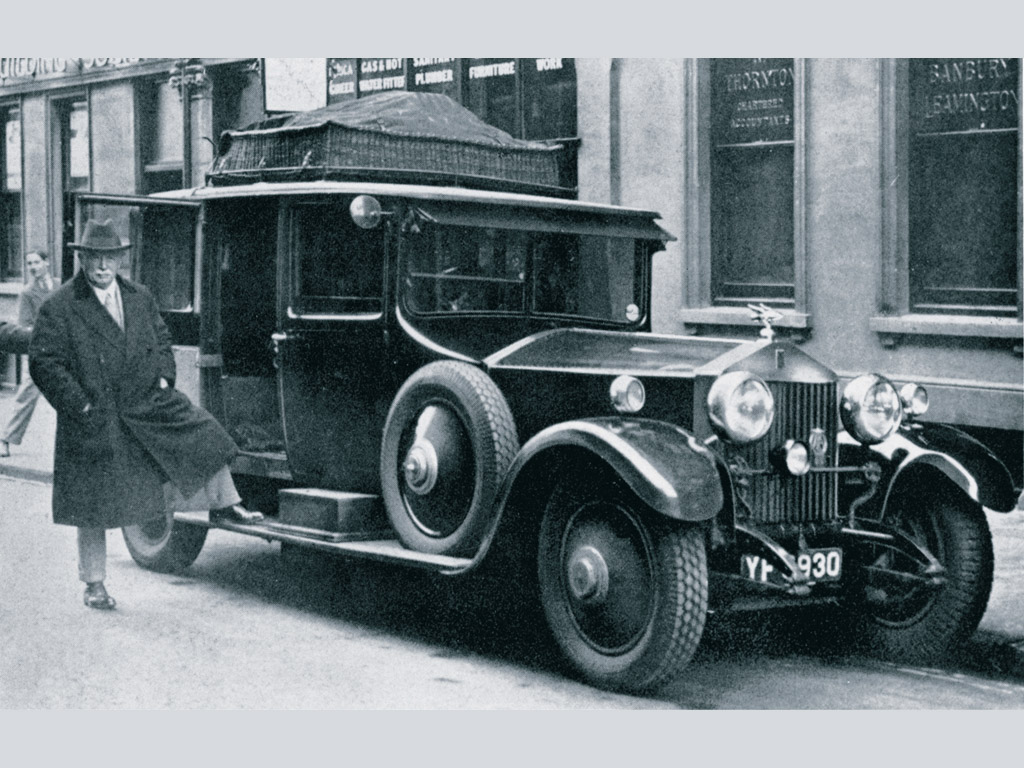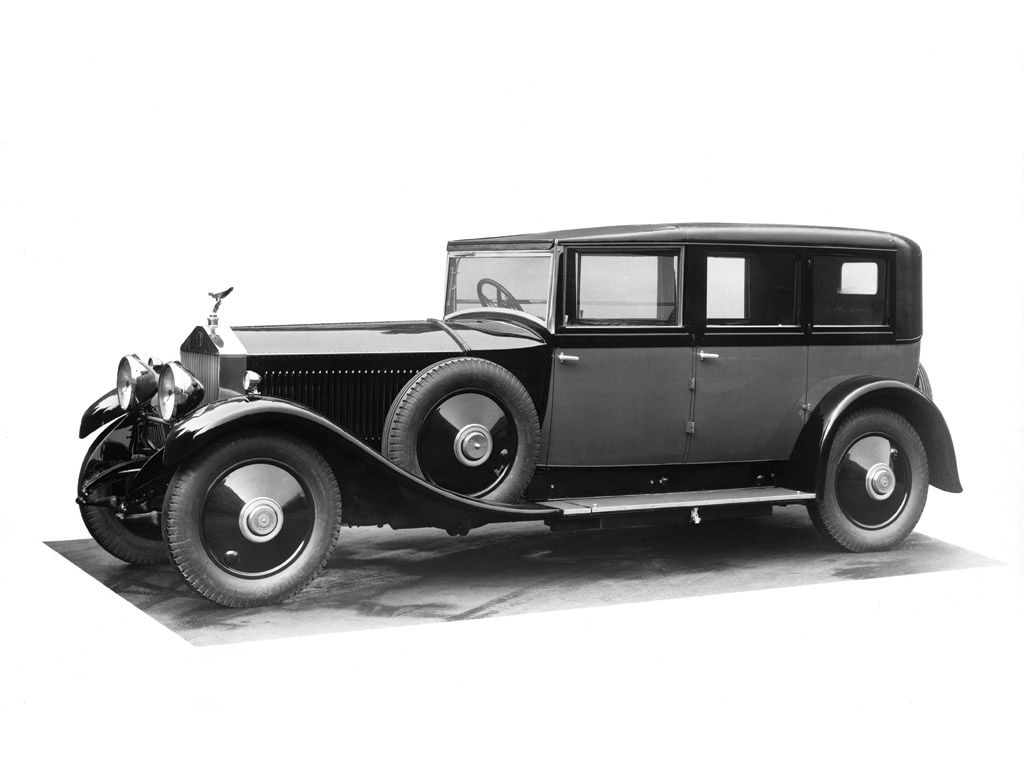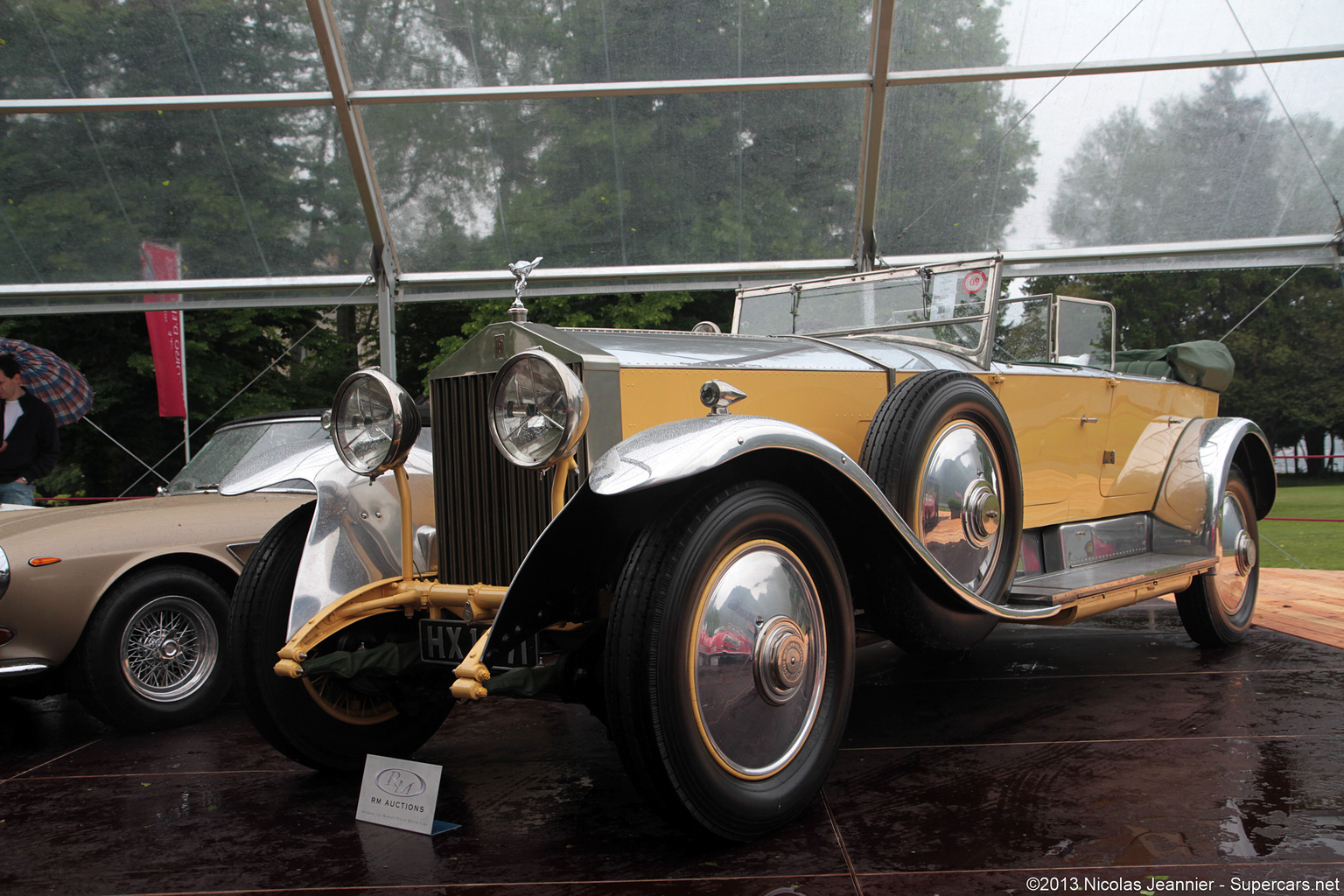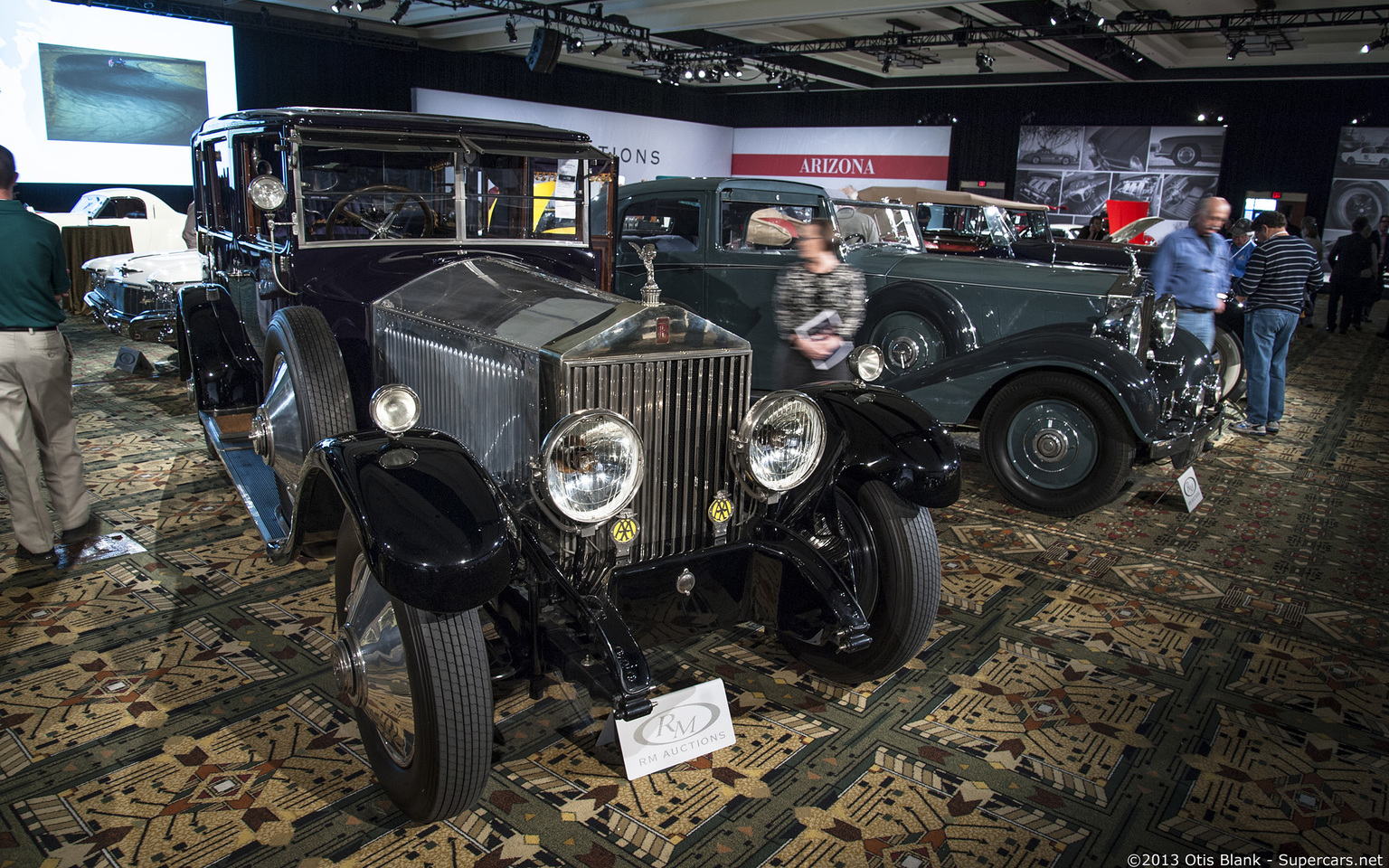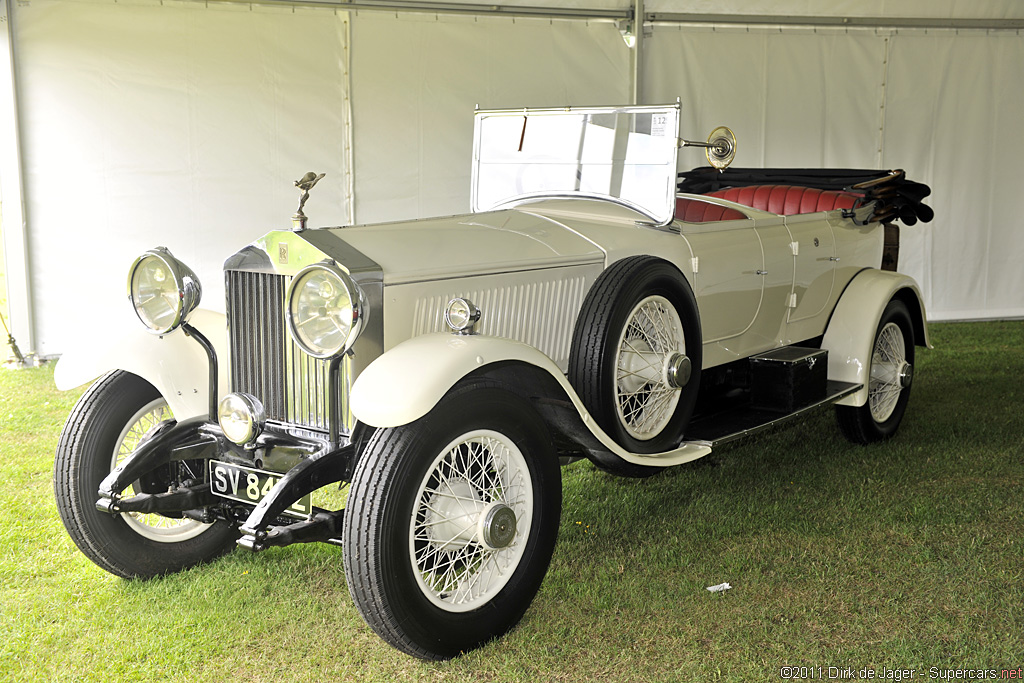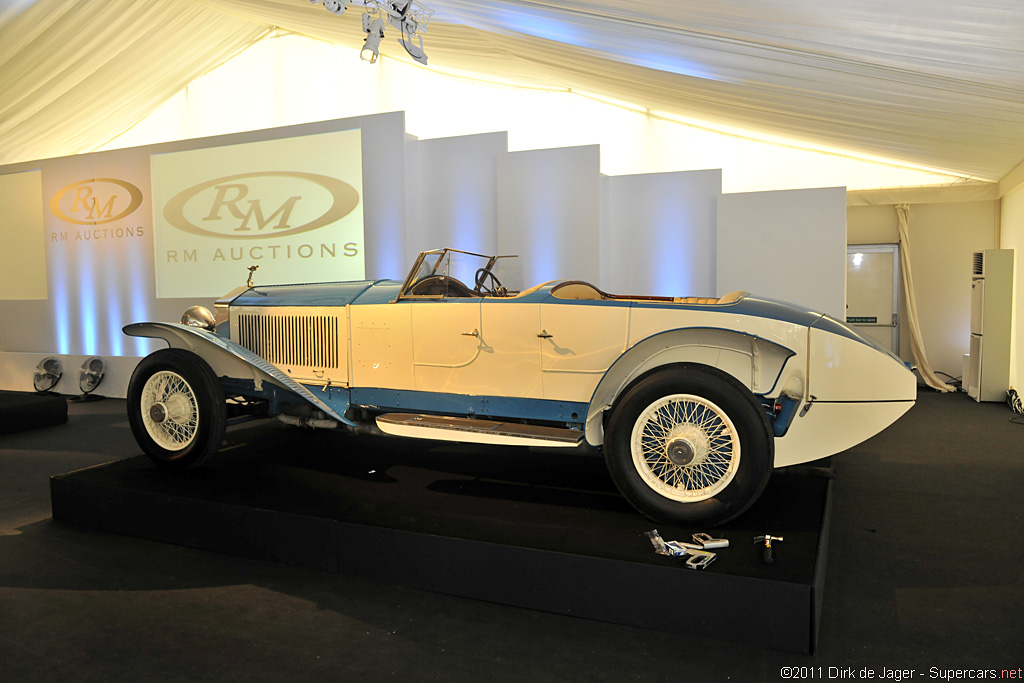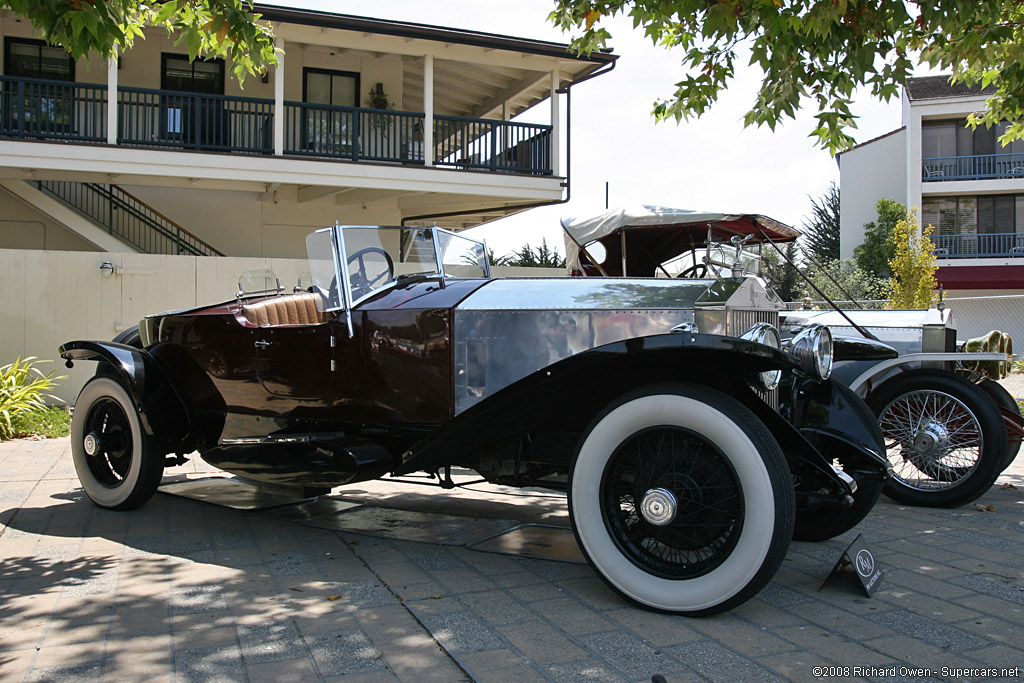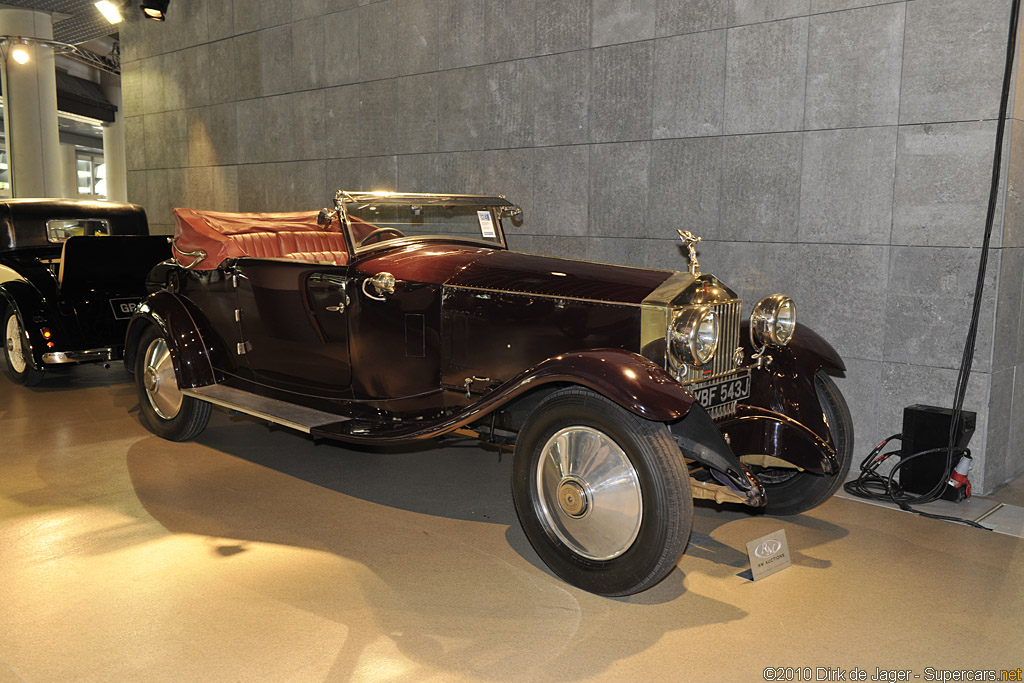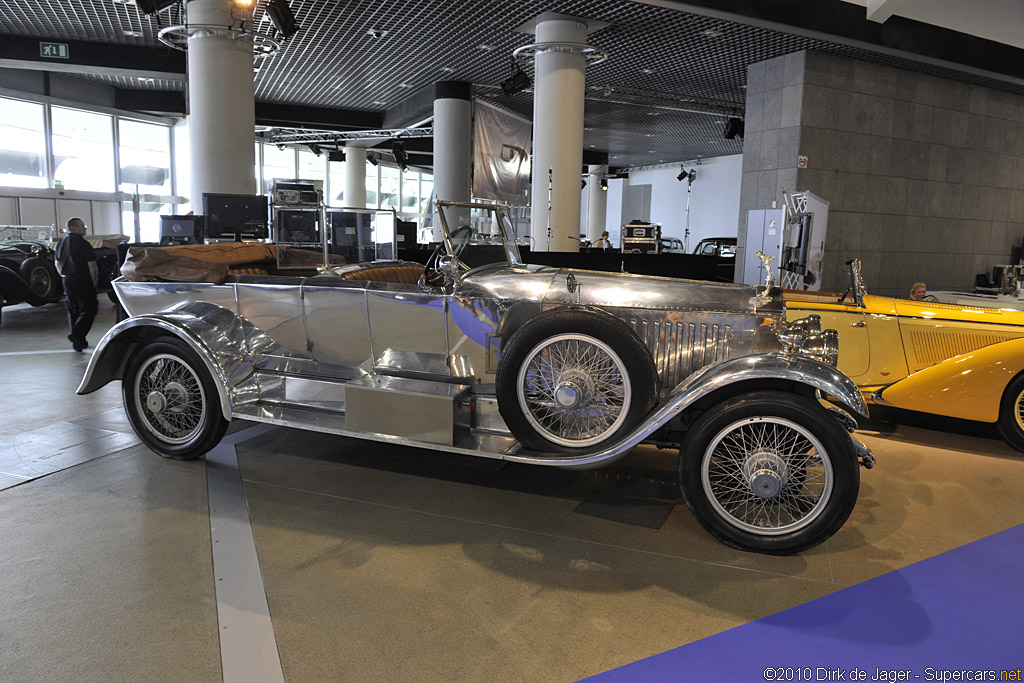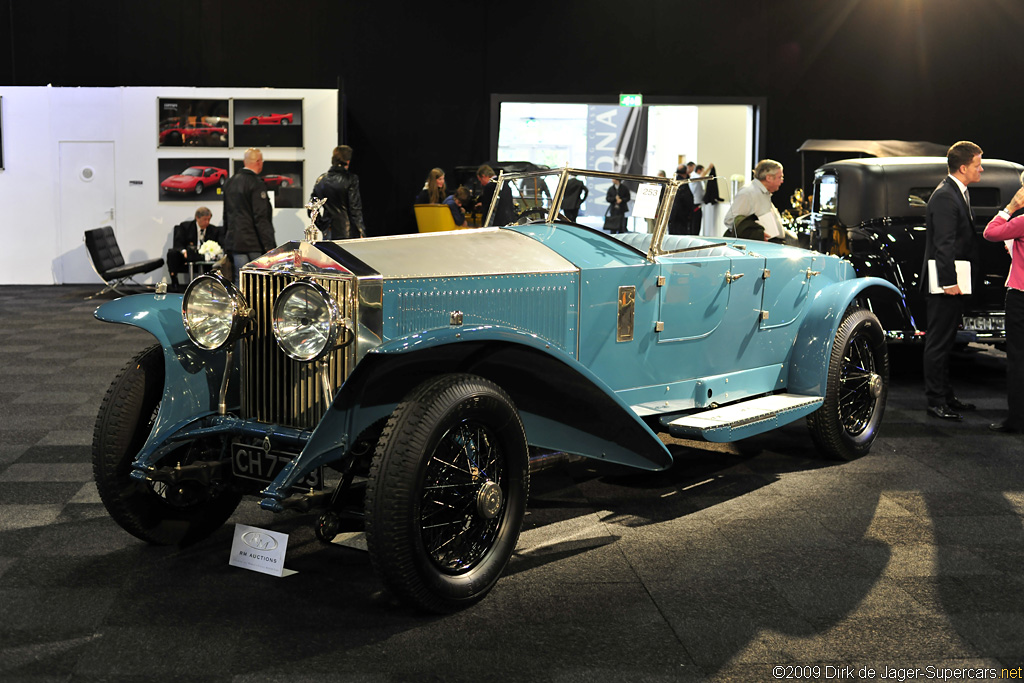1925→1931 Rolls-Royce Phantom I
Called the New Phantom or 40/50HP Phantom on it’s release, this model replaced the Silver Ghost with updates to the chassis and running gear. It was Roll-Royce’s flagship model until the Phantom II was released in 1929.
Compared to the Silver Ghost, the single biggest upgrade was made to the engine which was cast in three blocks, each having two cylinders and detachable cylinder heads. With a pushrod, overhead valvetrain the 7,668 cc unit was powerful enough to move around large cars. The engine’s under square engine could run smoother and a lower rpm with a favorable torque curve.
The Engine was attached to a separate 4-speed gearbox unit through a rubber coupling to reduce vibration. Power was send to the rear wheels though a torque tube.
Other upgrades from the Phantom included a disc-type clutch and adjustable radiator shutters.
A complex system of levers and suspension required constant oiling to as many as 50 separate points. The standard chassis was 143.5 inches long and a long wheel base model 150.5 inches.
Throughout production, the Phantom was upgraded in detail such as the cylinder which was cast in aluminum from 1928 onward.
The Phantom I was a great sucess for Roll-Royce which was extended to the Springfield, Massachusetts plant. American versions featured slightly different wheelbases, a 3-speed transmission and some lacked front brakes.
In Detail
| submitted by | Richard Owen |
| type | Series Production Car |
| production years | 1925 – 1931 |
| built at | Derby, England |
| production | 2269 |
| succeccesor | 1929 Rolls-Royce Phantom II |
| engine | Cast Iron Straight-6 |
| position | Front Longitudinal |
| aspiration | Natural |
| ignition | Dual Ignition via Coil & Magneto |
| block material | Cast Iron |
| valvetrain | OHV, 2 Valves per Cyl |
| fuel feed | Rolls Royce Carburetor |
| displacement | 7668 cc / 467.9 in³ |
| bore | 108 mm / 4.3 in |
| stroke | 139.7 mm / 5.5 in |
| power | 80.5 kw / 108 bhp @ 2300 rpm |
| specific output | 14.08 bhp per litre |
| body / frame | Steel Frame |
| front brakes | Drums |
| rear brakes | Drums |
| f suspension | Solid Axle w/Semi-Elliptic Leaf Springs, Friction Dampers |
| r suspension | Live Axle w/Springs, Friction Dampers |
| wheelbase | 3283 mm / 129.3 in |
| front track | 1461 mm / 57.5 in |
| rear track | 1461 mm / 57.5 in |
| transmission | 4-Speed Manual |
| tran clutch | Single Dry Plate |
Auction Sales History
1929 Rolls-Royce Phantom I Tourer 82OR – sold for €268,800 An original Rolls-Royce factory test car for 1929, with original engine, chassis, and body. Attractive Barker tourer coachwork, restored in eye-catching original colours. Fascinating history. Winner of the Lucius Beebe Trophy at the Pebble Beach Concours d’Elegance.
Auction Source: 2013 Villa d’Erba Auction by RM
1927 Rolls-Royce Phantom I Mulliner Enclosed Drive Landaulette 71RF – sold for $198,000 Offered from the Estate of John O’Quinn. Originally delivered to the Maharajah of Baroda. A sumptuously outfitted “throne room on wheels”.
Auction Source: 2013 Arizona Auction by RM
1925 Rolls-Royce Phantom I Tourer 8MC – did not sell for €94,215 According to a copy of the original build sheet, the early-production Phantom I offered here, chassis 8 MC, was fitted with a “C”-type steering column and came of test on 27 July 1925. The next day, it was sold to W.H. Peckitt, Esq. who was then residing at the Hotel Metropole in Folkestone. The car was despatched for bodywork on 26 August 1925. Copies of the ownership records name the subsequent owner as A.C. Roberts of Kent on 2 March 1934, followed by K.G. Bryant, Esq. of Penhalonga, Rhodesia on 22 April 1966.
At some point, the original engine of 8 MC, numbered YF 95, was replaced. Engine number DS 7917 currently resides under the bonnet. Prior to acquisition by the current owner, the car formed part of an Austrian museum collection for a period of eight years. More recently, the car was re-bodied with appropriate, large four-door touring coachwork, and among the great period features of this car, it includes a folding front windscreen, a rear windscreen, dual side-mounted spare wheels and tyres, Lucas P100 headlamps and more. As offered today, it is well presented with an Ivory exterior finish, a very nice red leather interior, a black hood, body-coloured wire-spoke wheels and a rear-mounted trunk.
Auction Source: 2011 Salon Privé Auction by RM
926 Rolls-Royce Phantom I Experimental Sports Tourer by Barker & Co. – sold for €447,664 One of the most significant experimental Rolls-Royces, the “CJ Sports Car”. Documented continuous history, including fascinating early performance testing. The only experimental Phantom I to be kept by Rolls-Royce for several years after testing.
Auction Source: 2011 Salon Privé Auction by RM
1928 Rolls-Royce Phantom I Boattail Tourer 99EH – sold for $110,000 New Phantom chassis 99EH was ordered by J.H. Van Oden of 43 Park Lane, London. Its testing completed on February 18, 1928, Rolls-Royce delivered it to coachbuilders Thrupp and Maberly on the 23rd. Thrupp and Maberly, then owned by Rootes, Ltd., proceeded to clothe it with a Fixed Cabriolet body, sometimes called “Faux Cabriolet,” an open-drive car whose passenger compartment has a roof that looks collapsible but is fixed in place. Before delivery, however, the car was sold to His Highness Prince Mdivani and shipped to New York, where it arrived on the 27th of June.
Its subsequent ownership history until purchase by collector S. Prestley Blake has been lost, but at some point during the 1950s it was returned to England and re-bodied by FLM Panelcraft with a replica of the Barker Boattail Tourer. It has a rear seat with room for two behind the main cockpit, which is shielded by twin racing-type windscreens. A removable cloth top shelters the front passengers, while the rear compartment has a tonneau cover only.
Auction Source: 2008 Monterey Preview
1925 Rolls-Royce 40/50 hp Phantom I Cabriolet by Manessius – sold for €131,600 Rolls-Royce introduced the New Phantom, later to be known as “Phantom I,” as a successor to the long-running Silver Ghost in May 1925. The engine was new, with overhead-valves and a larger, 7,668 cc displacement. The chassis record for this particular Phantom I, 59LC, shows that it was ordered on 13th July 1925 by racing driver and Madrid distributor Don Carlos de Salamanca for one Mr. Lanser. Originally scheduled as a cabriolet by Manessius of Paris, there are notations that a three-passenger torpedo was later contemplated. In any case, the chassis came off test on 12th October and was shipped on 22nd December 1925 to Boulogne.
Carrosserie Manessius was founded in 1919 by Manès Levy in the Parisian suburb of Puteaux. The name was a Latinisation of Levy’s forename, and the business was very successful, so Levy moved to a new and larger facility in Levallois-Perret in 1922. A leader in innovative construction techniques, he pioneered in all-metal construction, body mounting and painting methods, as well as the conduite intérieure integral luggage compartment.
A notation on the chassis card shows it was sold to Clément van der Stratten of Brussels on 26th March 1928. The later history is unknown, but later modifications had included the fitting of a fixed roof. Completely restored between 1995 and 1998, 59LC was found to have the underpinnings of the originally-designated cabriolet body and was restored back to the original open design. In the ensuing years it has acquired a pleasant patina, both body and leather. The colours were carefully selected to replicate those in vogue during the mid-1920s. The wood looks original, the engine runs very smoothly, and the car drives very well.
Auction Source: 2010 RM Auctions Sporting Classics of Monaco
1926 Rolls-Royce 40/50 hp Phantom I Open Tourer by Windover Open Tourer 6YC – sold for €170,000 The construction of this particular Phantom I, chassis 6YC, was originally commissioned by Syed Mohammad Sa’adat Ali Khan, who became the Rajah of Nanpara as a seven-year-old in 1911. Chassis 6YC came “off test” on 3rd July 1926. For the design and construction of a suitably regal open touring body, His Highness entrusted Windover, the long-standing and highly respected London coachbuilders who had already established an enviable clientele among the fabulously wealthy Indian Princes.
With origins dating to 1600, Windovers were saddlers and harness-makers until the onset of the Industrial Revolution, when they moved north to engage in carriage and coach building. Windover-built carriages developed a loyal following and were in evidence throughout the British Empire, as well as the royal households of England and other European locales. As the motoring age dawned, Windover was a natural choice to produce bodies for the top marques, including Rolls-Royce and Bentley.
The example offered here, Phantom I chassis 6YC, is nothing short of an “Aluminium Sculpture.” Mr. Zach acquired it in 2000. Its original Windover bodywork, with 400 hours of careful polishing, remains quite simply a masterpiece of design and execution. With a remarkable purity of line that is undisturbed by any external door handles, the body ends with a neat, flat boattail treatment at the rear and remains among the finest examples of the custom coachbuilder’s art.
Between 2005 and 2006, many bright exterior components, including the lamps, window frames and radiator, were removed from the car and restored. The centre-mounted spotlight was installed, and the aluminium covers over the tank and front springs were fabricated by Mr. Zach’s craftsmen. Inside, the rich leather upholstery displays a very nice patina. Underhood, the massive and powerful inline six-cylinder engine has been restored and is reported to run very smoothly, in keeping with the finest Rolls-Royce tradition. Although 6YC has recently been made available in miniature form as a highly detailed 1:43-scale model by the Van Dooren studio of Paris, the full-scale original is undoubtedly a must-have for Rolls-Royce collectors.
Auction Source: 2010 RM Auctions Sporting Classics of Monaco
1928 Rolls-Royce Phantom I Torpedo 17EX – sold for €482,625 Royce was pleased with the result, and it was decided that three more “experimental” cars were to be built. The three that followed were15EX, 16EX and 17EX, coachbuilt respectively by Hooper, Barker and Jarvis of Wimbledon. 15EX was sent off to Europe for extensive high speed testing, but it met with a catastrophic accident in France. 16EX spent most of its life in the UK, changing hands several times and eventually finding its way to the US, where after some years in the Blackhawk Collection, it is now with a private collector.
17EX travelled the world. Noticeably quicker than 10EX, it developed 92.6 bhp at the dyno, going up to 99.5 bhp with the cutout open when the car was bench tested at the Rolls-Royce works in Derby. Extensive testing was carried out on 17EX – some 4,500 miles, of which half was without the body. Interestingly, the car had many unique features including a shortened steering column and an engine positioned slightly forward.
The car was sold to the Maharaja Hari Singh Bahadur (just 33 years old at the time), ruler of Jammu and Kashmir. He bought it just before Christmas of 1928 for a discounted price of 42,000 Rupees (about $9,150). Members of his family were very good clients of the company, as it was said they already owned no fewer than 26 Rolls-Royce. The Maharaja kept the car until 1932, then sold it to a certain Ram Narain of Kanpur, an important industrial town east of Delhi.
A few months later P.K. Mitter of Calcutta, a well-known connoisseur of very exclusive cars (including a Duesenberg and an Isotta-Fraschini, the latter being sold to finance the acquisition of Rolls-Royce’s experimental car), acquired 17EX, and he used it for some 11 years. In fact, his son Jayanta Mitter recalls 17EX very fondly, mentioning that its performance abilities struck a nice chord between the Duesenberg J roadster of his father (and that of his uncle, who too had a Duesenberg) and his uncle’s 1938 Mercedes-Benz 250. The Duesenberg was faster overall, while the Mercedes was good for short bursts. But 17EX was undoubtedly the most striking of the lot. And interestingly, 17EX was sold when P.K. Mitter decided to acquire a Packard that was advertised to do a genuine 100 mph.
17EX then went to Greta Devi of Allahabad (another prominent city east of Delhi) in 1944. A West Bengal registration document dated 1956 indicates a transfer of ownership between one Sukosh Banerjee and Bimal Kanti Ghose, both of Calcutta, but the next long-term owner was the Raja Saheb (more a landed gentry than a true royal) of the remote princely state of Bhadri in the north central province of Madhya Pradesh. Sometime in the 1960s, news of the car’s existence reached the ear of Protap Roy, a scion of the princely family of Santosh (which is in Bangladesh now) who eventually persuaded the Raja Saheb to part with 17EX in 1967.
But as Roy had a penchant for acquiring cars – and cash was limited – for every new acquisition he had to sell something from his collection. And so it came to pass that 17EX was eventually sold to Christopher Renwick, who in turn had the car shipped out of India, eventually selling 17EX to two Italians Veniero Molari and Giulio Vignale (the nephew of coachbuilder Alfredo Vignale) in 1976.
In the 1990s, Molari and Vignale decided to entrust the job of restoring 17EX to Gianni Pena, who worked as a model maker for many of the coachbuilders of Turin. When the car was with Pena, the current owner came across 17EX, fell in love with it, and decided to acquire the car. After extensive restoration work, the car was ready for Pebble Beach in 2004 – in time for Rolls-Royce’s 100th anniversary. 17EX was back in the limelight again when it won the Trofeo Rolls-Royce as the Most Elegant Rolls-Royce at the 2006 edition of the Villa d’Este.
This is certainly a magnificent, one-of-a-kind Rolls-Royce with unique provenance, to say the least. Without question, its offering marks an opportunity that may never again be repeated in one’s lifetime.
Auction Source: 2009 RM Auctions’ Automobiles of London


